Tax Law Assignment: Fringe Benefits Tax and Capital Gains Tax Analysis
VerifiedAdded on 2023/03/20
|8
|2539
|29
Homework Assignment
AI Summary
This document presents a comprehensive tax law assignment addressing two key areas: fringe benefits tax (FBT) and capital gains tax (CGT). The first part of the assignment examines the tax implications for Spiceco Pty Ltd, focusing on the provision of a car to an employee, Lucinda, and calculating the FBT liability using both the statutory and logbook methods. The analysis considers relevant legislation, including the FBTAA 1986, and case law to determine the appropriate tax treatment. The second part of the assignment deals with capital gains tax (CGT) for Daniel Ray, analyzing the CGT consequences of selling various assets, including a Doncaster residence, an artistic painting, a luxury yacht, and shares in BHP and AZJ. The analysis covers CGT events, the classification of assets (collectables, personal use assets), and the offsetting of capital losses against capital gains. The assignment concludes with recommendations for Daniel regarding investing capital gains and the treatment of capital losses, providing a detailed overview of the relevant tax principles and their application to the given scenarios.
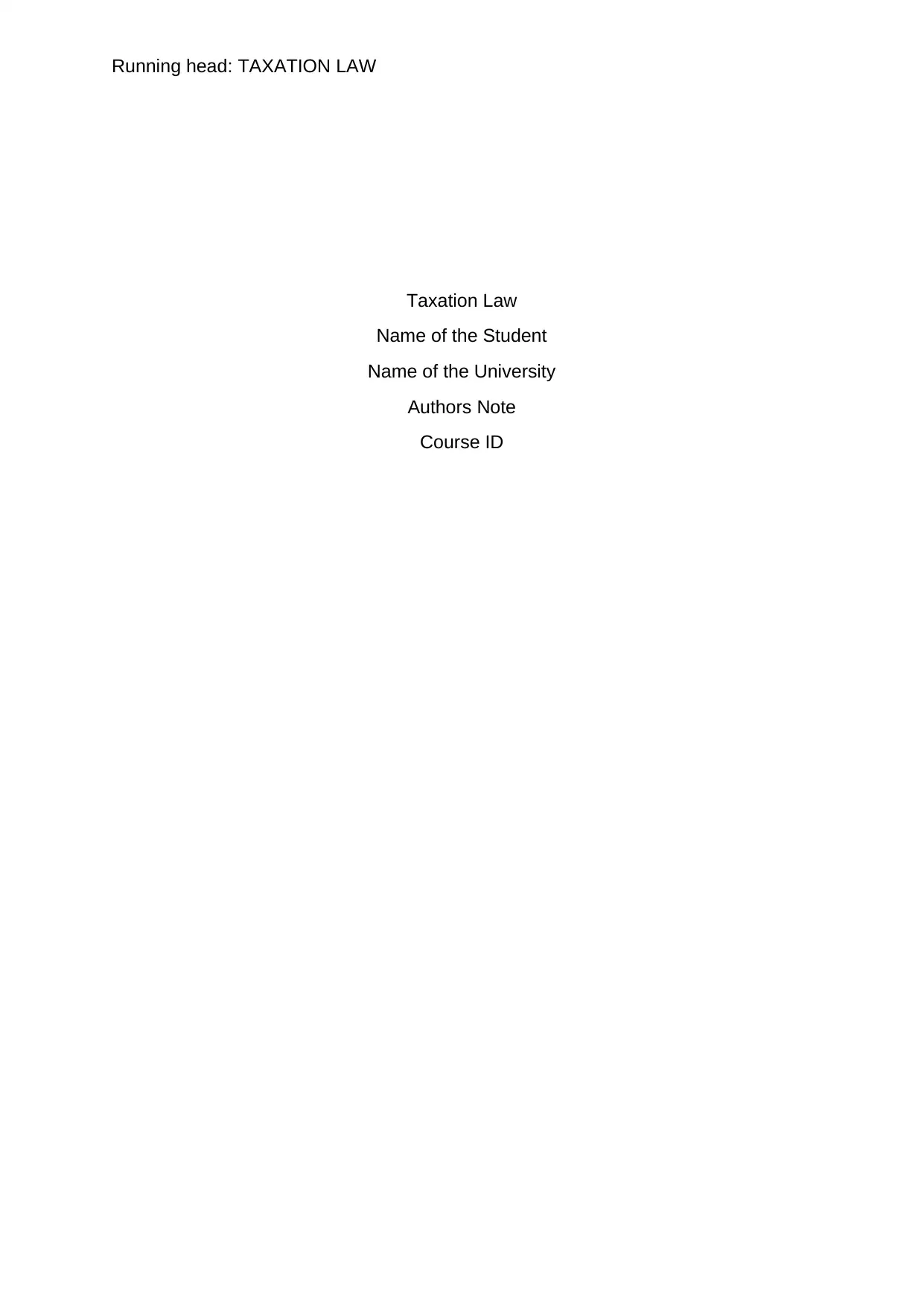
Running head: TAXATION LAW
Taxation Law
Name of the Student
Name of the University
Authors Note
Course ID
Taxation Law
Name of the Student
Name of the University
Authors Note
Course ID
Paraphrase This Document
Need a fresh take? Get an instant paraphrase of this document with our AI Paraphraser
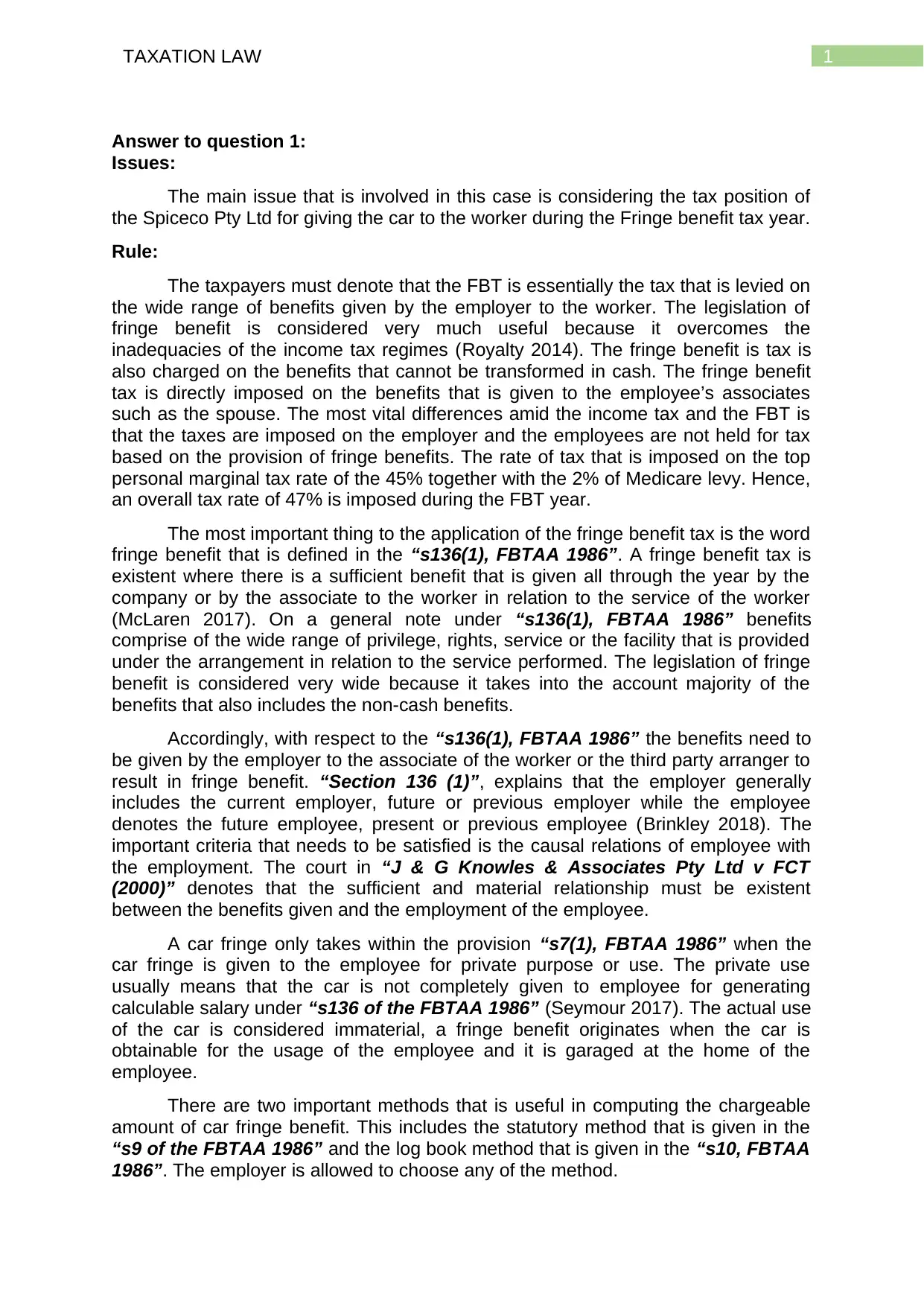
1TAXATION LAW
Answer to question 1:
Issues:
The main issue that is involved in this case is considering the tax position of
the Spiceco Pty Ltd for giving the car to the worker during the Fringe benefit tax year.
Rule:
The taxpayers must denote that the FBT is essentially the tax that is levied on
the wide range of benefits given by the employer to the worker. The legislation of
fringe benefit is considered very much useful because it overcomes the
inadequacies of the income tax regimes (Royalty 2014). The fringe benefit is tax is
also charged on the benefits that cannot be transformed in cash. The fringe benefit
tax is directly imposed on the benefits that is given to the employee’s associates
such as the spouse. The most vital differences amid the income tax and the FBT is
that the taxes are imposed on the employer and the employees are not held for tax
based on the provision of fringe benefits. The rate of tax that is imposed on the top
personal marginal tax rate of the 45% together with the 2% of Medicare levy. Hence,
an overall tax rate of 47% is imposed during the FBT year.
The most important thing to the application of the fringe benefit tax is the word
fringe benefit that is defined in the “s136(1), FBTAA 1986”. A fringe benefit tax is
existent where there is a sufficient benefit that is given all through the year by the
company or by the associate to the worker in relation to the service of the worker
(McLaren 2017). On a general note under “s136(1), FBTAA 1986” benefits
comprise of the wide range of privilege, rights, service or the facility that is provided
under the arrangement in relation to the service performed. The legislation of fringe
benefit is considered very wide because it takes into the account majority of the
benefits that also includes the non-cash benefits.
Accordingly, with respect to the “s136(1), FBTAA 1986” the benefits need to
be given by the employer to the associate of the worker or the third party arranger to
result in fringe benefit. “Section 136 (1)”, explains that the employer generally
includes the current employer, future or previous employer while the employee
denotes the future employee, present or previous employee (Brinkley 2018). The
important criteria that needs to be satisfied is the causal relations of employee with
the employment. The court in “J & G Knowles & Associates Pty Ltd v FCT
(2000)” denotes that the sufficient and material relationship must be existent
between the benefits given and the employment of the employee.
A car fringe only takes within the provision “s7(1), FBTAA 1986” when the
car fringe is given to the employee for private purpose or use. The private use
usually means that the car is not completely given to employee for generating
calculable salary under “s136 of the FBTAA 1986” (Seymour 2017). The actual use
of the car is considered immaterial, a fringe benefit originates when the car is
obtainable for the usage of the employee and it is garaged at the home of the
employee.
There are two important methods that is useful in computing the chargeable
amount of car fringe benefit. This includes the statutory method that is given in the
“s9 of the FBTAA 1986” and the log book method that is given in the “s10, FBTAA
1986”. The employer is allowed to choose any of the method.
Answer to question 1:
Issues:
The main issue that is involved in this case is considering the tax position of
the Spiceco Pty Ltd for giving the car to the worker during the Fringe benefit tax year.
Rule:
The taxpayers must denote that the FBT is essentially the tax that is levied on
the wide range of benefits given by the employer to the worker. The legislation of
fringe benefit is considered very much useful because it overcomes the
inadequacies of the income tax regimes (Royalty 2014). The fringe benefit is tax is
also charged on the benefits that cannot be transformed in cash. The fringe benefit
tax is directly imposed on the benefits that is given to the employee’s associates
such as the spouse. The most vital differences amid the income tax and the FBT is
that the taxes are imposed on the employer and the employees are not held for tax
based on the provision of fringe benefits. The rate of tax that is imposed on the top
personal marginal tax rate of the 45% together with the 2% of Medicare levy. Hence,
an overall tax rate of 47% is imposed during the FBT year.
The most important thing to the application of the fringe benefit tax is the word
fringe benefit that is defined in the “s136(1), FBTAA 1986”. A fringe benefit tax is
existent where there is a sufficient benefit that is given all through the year by the
company or by the associate to the worker in relation to the service of the worker
(McLaren 2017). On a general note under “s136(1), FBTAA 1986” benefits
comprise of the wide range of privilege, rights, service or the facility that is provided
under the arrangement in relation to the service performed. The legislation of fringe
benefit is considered very wide because it takes into the account majority of the
benefits that also includes the non-cash benefits.
Accordingly, with respect to the “s136(1), FBTAA 1986” the benefits need to
be given by the employer to the associate of the worker or the third party arranger to
result in fringe benefit. “Section 136 (1)”, explains that the employer generally
includes the current employer, future or previous employer while the employee
denotes the future employee, present or previous employee (Brinkley 2018). The
important criteria that needs to be satisfied is the causal relations of employee with
the employment. The court in “J & G Knowles & Associates Pty Ltd v FCT
(2000)” denotes that the sufficient and material relationship must be existent
between the benefits given and the employment of the employee.
A car fringe only takes within the provision “s7(1), FBTAA 1986” when the
car fringe is given to the employee for private purpose or use. The private use
usually means that the car is not completely given to employee for generating
calculable salary under “s136 of the FBTAA 1986” (Seymour 2017). The actual use
of the car is considered immaterial, a fringe benefit originates when the car is
obtainable for the usage of the employee and it is garaged at the home of the
employee.
There are two important methods that is useful in computing the chargeable
amount of car fringe benefit. This includes the statutory method that is given in the
“s9 of the FBTAA 1986” and the log book method that is given in the “s10, FBTAA
1986”. The employer is allowed to choose any of the method.
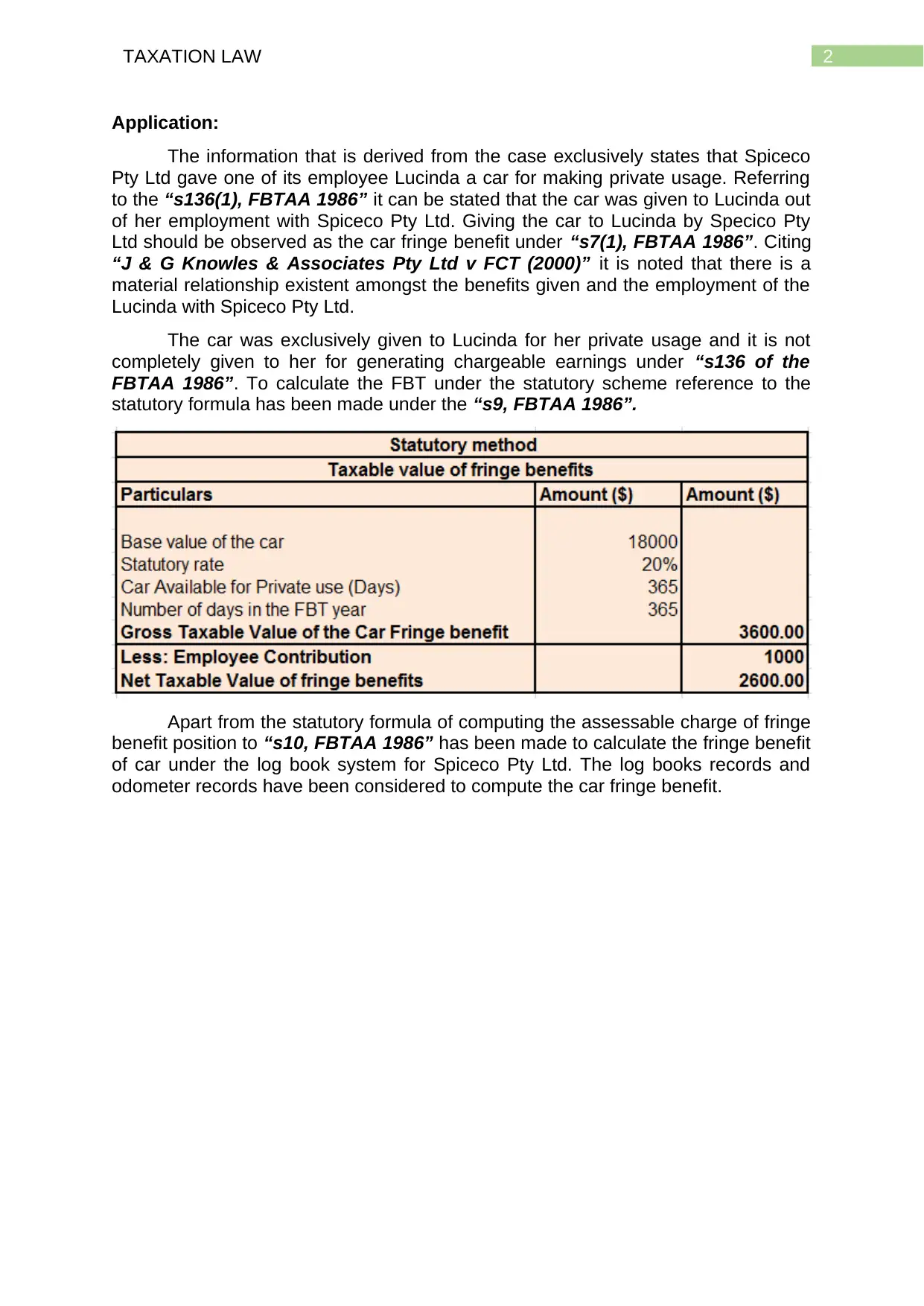
2TAXATION LAW
Application:
The information that is derived from the case exclusively states that Spiceco
Pty Ltd gave one of its employee Lucinda a car for making private usage. Referring
to the “s136(1), FBTAA 1986” it can be stated that the car was given to Lucinda out
of her employment with Spiceco Pty Ltd. Giving the car to Lucinda by Specico Pty
Ltd should be observed as the car fringe benefit under “s7(1), FBTAA 1986”. Citing
“J & G Knowles & Associates Pty Ltd v FCT (2000)” it is noted that there is a
material relationship existent amongst the benefits given and the employment of the
Lucinda with Spiceco Pty Ltd.
The car was exclusively given to Lucinda for her private usage and it is not
completely given to her for generating chargeable earnings under “s136 of the
FBTAA 1986”. To calculate the FBT under the statutory scheme reference to the
statutory formula has been made under the “s9, FBTAA 1986”.
Apart from the statutory formula of computing the assessable charge of fringe
benefit position to “s10, FBTAA 1986” has been made to calculate the fringe benefit
of car under the log book system for Spiceco Pty Ltd. The log books records and
odometer records have been considered to compute the car fringe benefit.
Application:
The information that is derived from the case exclusively states that Spiceco
Pty Ltd gave one of its employee Lucinda a car for making private usage. Referring
to the “s136(1), FBTAA 1986” it can be stated that the car was given to Lucinda out
of her employment with Spiceco Pty Ltd. Giving the car to Lucinda by Specico Pty
Ltd should be observed as the car fringe benefit under “s7(1), FBTAA 1986”. Citing
“J & G Knowles & Associates Pty Ltd v FCT (2000)” it is noted that there is a
material relationship existent amongst the benefits given and the employment of the
Lucinda with Spiceco Pty Ltd.
The car was exclusively given to Lucinda for her private usage and it is not
completely given to her for generating chargeable earnings under “s136 of the
FBTAA 1986”. To calculate the FBT under the statutory scheme reference to the
statutory formula has been made under the “s9, FBTAA 1986”.
Apart from the statutory formula of computing the assessable charge of fringe
benefit position to “s10, FBTAA 1986” has been made to calculate the fringe benefit
of car under the log book system for Spiceco Pty Ltd. The log books records and
odometer records have been considered to compute the car fringe benefit.
⊘ This is a preview!⊘
Do you want full access?
Subscribe today to unlock all pages.

Trusted by 1+ million students worldwide
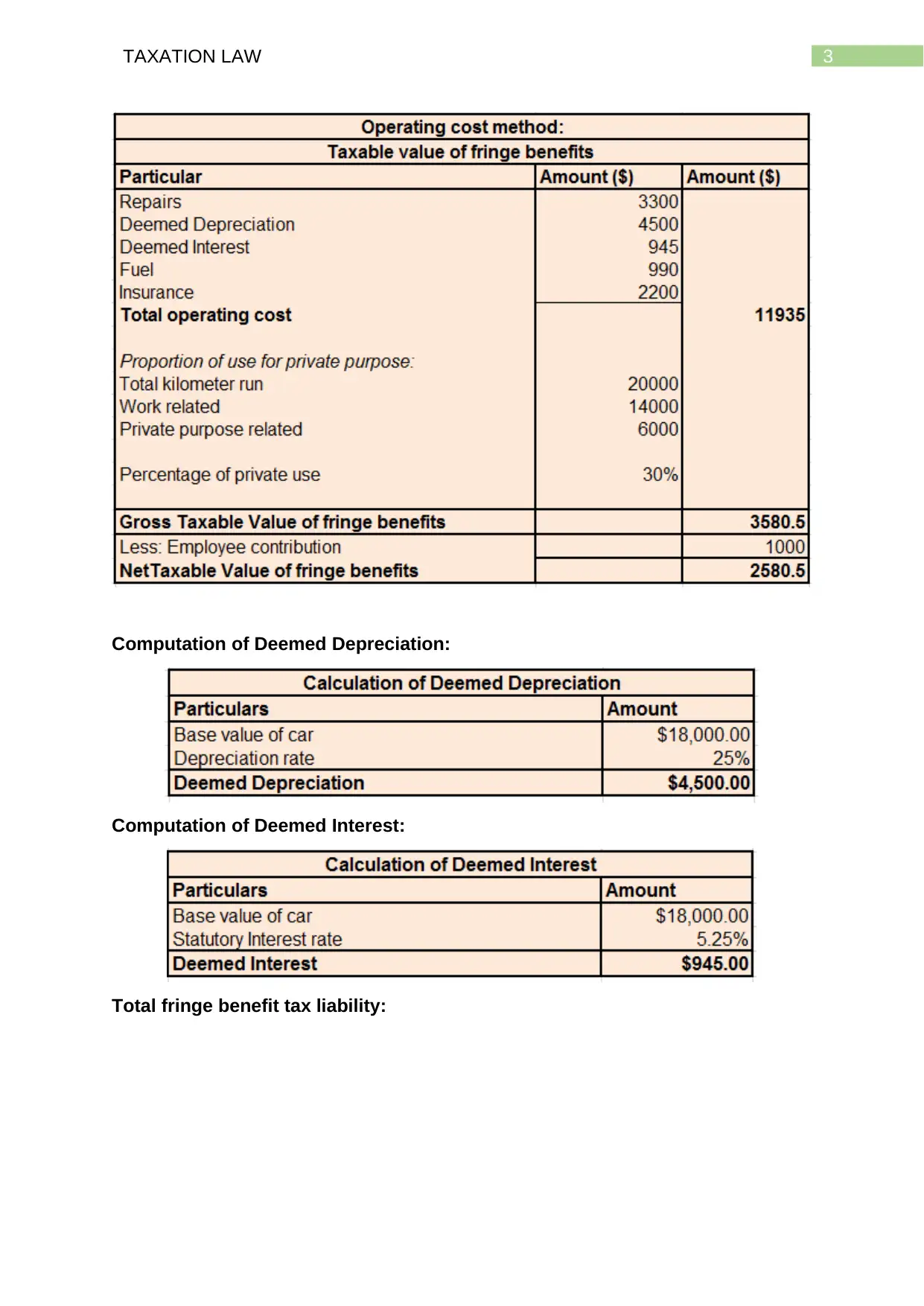
3TAXATION LAW
Computation of Deemed Depreciation:
Computation of Deemed Interest:
Total fringe benefit tax liability:
Computation of Deemed Depreciation:
Computation of Deemed Interest:
Total fringe benefit tax liability:
Paraphrase This Document
Need a fresh take? Get an instant paraphrase of this document with our AI Paraphraser
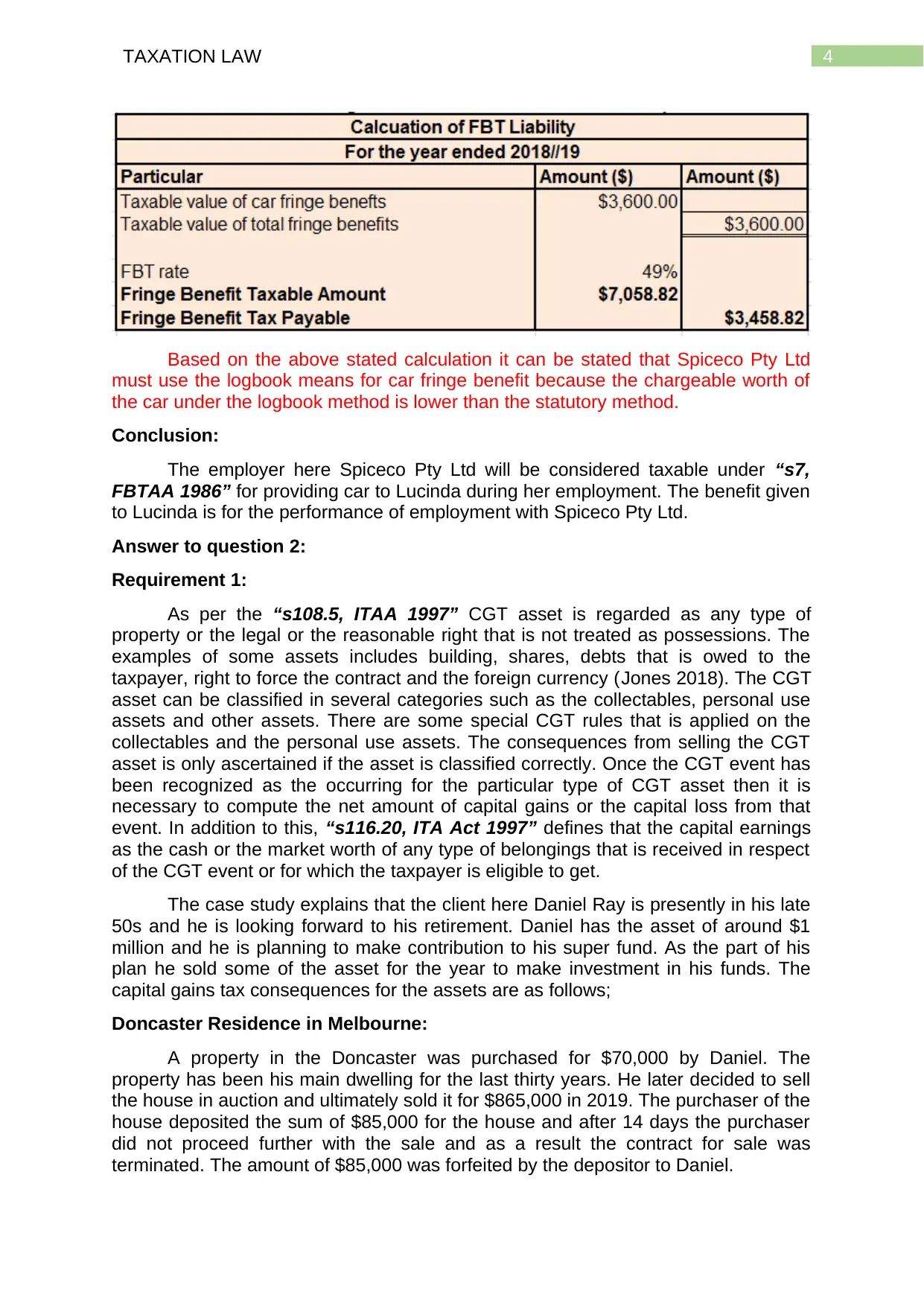
4TAXATION LAW
Based on the above stated calculation it can be stated that Spiceco Pty Ltd
must use the logbook means for car fringe benefit because the chargeable worth of
the car under the logbook method is lower than the statutory method.
Conclusion:
The employer here Spiceco Pty Ltd will be considered taxable under “s7,
FBTAA 1986” for providing car to Lucinda during her employment. The benefit given
to Lucinda is for the performance of employment with Spiceco Pty Ltd.
Answer to question 2:
Requirement 1:
As per the “s108.5, ITAA 1997” CGT asset is regarded as any type of
property or the legal or the reasonable right that is not treated as possessions. The
examples of some assets includes building, shares, debts that is owed to the
taxpayer, right to force the contract and the foreign currency (Jones 2018). The CGT
asset can be classified in several categories such as the collectables, personal use
assets and other assets. There are some special CGT rules that is applied on the
collectables and the personal use assets. The consequences from selling the CGT
asset is only ascertained if the asset is classified correctly. Once the CGT event has
been recognized as the occurring for the particular type of CGT asset then it is
necessary to compute the net amount of capital gains or the capital loss from that
event. In addition to this, “s116.20, ITA Act 1997” defines that the capital earnings
as the cash or the market worth of any type of belongings that is received in respect
of the CGT event or for which the taxpayer is eligible to get.
The case study explains that the client here Daniel Ray is presently in his late
50s and he is looking forward to his retirement. Daniel has the asset of around $1
million and he is planning to make contribution to his super fund. As the part of his
plan he sold some of the asset for the year to make investment in his funds. The
capital gains tax consequences for the assets are as follows;
Doncaster Residence in Melbourne:
A property in the Doncaster was purchased for $70,000 by Daniel. The
property has been his main dwelling for the last thirty years. He later decided to sell
the house in auction and ultimately sold it for $865,000 in 2019. The purchaser of the
house deposited the sum of $85,000 for the house and after 14 days the purchaser
did not proceed further with the sale and as a result the contract for sale was
terminated. The amount of $85,000 was forfeited by the depositor to Daniel.
Based on the above stated calculation it can be stated that Spiceco Pty Ltd
must use the logbook means for car fringe benefit because the chargeable worth of
the car under the logbook method is lower than the statutory method.
Conclusion:
The employer here Spiceco Pty Ltd will be considered taxable under “s7,
FBTAA 1986” for providing car to Lucinda during her employment. The benefit given
to Lucinda is for the performance of employment with Spiceco Pty Ltd.
Answer to question 2:
Requirement 1:
As per the “s108.5, ITAA 1997” CGT asset is regarded as any type of
property or the legal or the reasonable right that is not treated as possessions. The
examples of some assets includes building, shares, debts that is owed to the
taxpayer, right to force the contract and the foreign currency (Jones 2018). The CGT
asset can be classified in several categories such as the collectables, personal use
assets and other assets. There are some special CGT rules that is applied on the
collectables and the personal use assets. The consequences from selling the CGT
asset is only ascertained if the asset is classified correctly. Once the CGT event has
been recognized as the occurring for the particular type of CGT asset then it is
necessary to compute the net amount of capital gains or the capital loss from that
event. In addition to this, “s116.20, ITA Act 1997” defines that the capital earnings
as the cash or the market worth of any type of belongings that is received in respect
of the CGT event or for which the taxpayer is eligible to get.
The case study explains that the client here Daniel Ray is presently in his late
50s and he is looking forward to his retirement. Daniel has the asset of around $1
million and he is planning to make contribution to his super fund. As the part of his
plan he sold some of the asset for the year to make investment in his funds. The
capital gains tax consequences for the assets are as follows;
Doncaster Residence in Melbourne:
A property in the Doncaster was purchased for $70,000 by Daniel. The
property has been his main dwelling for the last thirty years. He later decided to sell
the house in auction and ultimately sold it for $865,000 in 2019. The purchaser of the
house deposited the sum of $85,000 for the house and after 14 days the purchaser
did not proceed further with the sale and as a result the contract for sale was
terminated. The amount of $85,000 was forfeited by the depositor to Daniel.
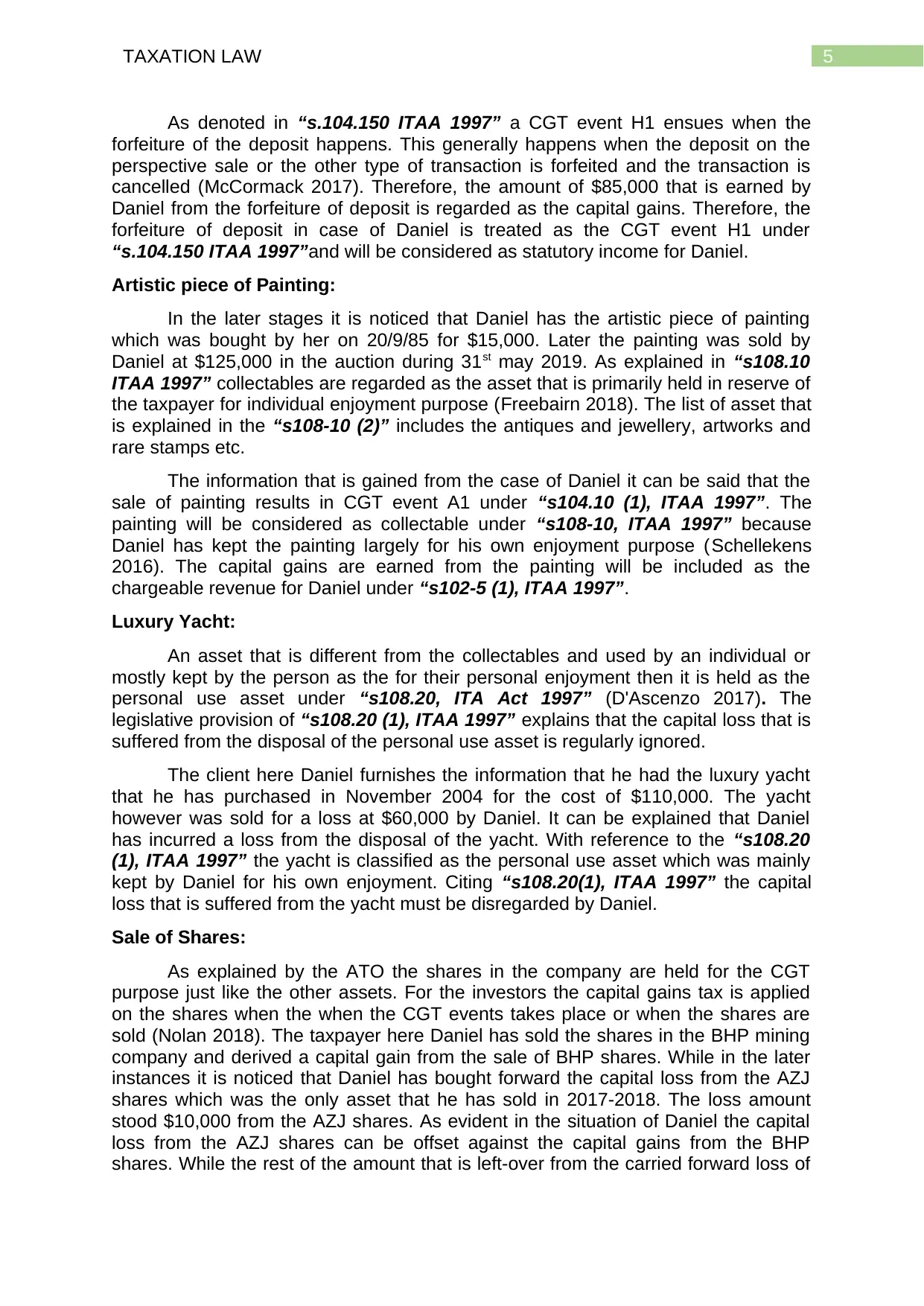
5TAXATION LAW
As denoted in “s.104.150 ITAA 1997” a CGT event H1 ensues when the
forfeiture of the deposit happens. This generally happens when the deposit on the
perspective sale or the other type of transaction is forfeited and the transaction is
cancelled (McCormack 2017). Therefore, the amount of $85,000 that is earned by
Daniel from the forfeiture of deposit is regarded as the capital gains. Therefore, the
forfeiture of deposit in case of Daniel is treated as the CGT event H1 under
“s.104.150 ITAA 1997”and will be considered as statutory income for Daniel.
Artistic piece of Painting:
In the later stages it is noticed that Daniel has the artistic piece of painting
which was bought by her on 20/9/85 for $15,000. Later the painting was sold by
Daniel at $125,000 in the auction during 31st may 2019. As explained in “s108.10
ITAA 1997” collectables are regarded as the asset that is primarily held in reserve of
the taxpayer for individual enjoyment purpose (Freebairn 2018). The list of asset that
is explained in the “s108-10 (2)” includes the antiques and jewellery, artworks and
rare stamps etc.
The information that is gained from the case of Daniel it can be said that the
sale of painting results in CGT event A1 under “s104.10 (1), ITAA 1997”. The
painting will be considered as collectable under “s108-10, ITAA 1997” because
Daniel has kept the painting largely for his own enjoyment purpose (Schellekens
2016). The capital gains are earned from the painting will be included as the
chargeable revenue for Daniel under “s102-5 (1), ITAA 1997”.
Luxury Yacht:
An asset that is different from the collectables and used by an individual or
mostly kept by the person as the for their personal enjoyment then it is held as the
personal use asset under “s108.20, ITA Act 1997” (D'Ascenzo 2017). The
legislative provision of “s108.20 (1), ITAA 1997” explains that the capital loss that is
suffered from the disposal of the personal use asset is regularly ignored.
The client here Daniel furnishes the information that he had the luxury yacht
that he has purchased in November 2004 for the cost of $110,000. The yacht
however was sold for a loss at $60,000 by Daniel. It can be explained that Daniel
has incurred a loss from the disposal of the yacht. With reference to the “s108.20
(1), ITAA 1997” the yacht is classified as the personal use asset which was mainly
kept by Daniel for his own enjoyment. Citing “s108.20(1), ITAA 1997” the capital
loss that is suffered from the yacht must be disregarded by Daniel.
Sale of Shares:
As explained by the ATO the shares in the company are held for the CGT
purpose just like the other assets. For the investors the capital gains tax is applied
on the shares when the when the CGT events takes place or when the shares are
sold (Nolan 2018). The taxpayer here Daniel has sold the shares in the BHP mining
company and derived a capital gain from the sale of BHP shares. While in the later
instances it is noticed that Daniel has bought forward the capital loss from the AZJ
shares which was the only asset that he has sold in 2017-2018. The loss amount
stood $10,000 from the AZJ shares. As evident in the situation of Daniel the capital
loss from the AZJ shares can be offset against the capital gains from the BHP
shares. While the rest of the amount that is left-over from the carried forward loss of
As denoted in “s.104.150 ITAA 1997” a CGT event H1 ensues when the
forfeiture of the deposit happens. This generally happens when the deposit on the
perspective sale or the other type of transaction is forfeited and the transaction is
cancelled (McCormack 2017). Therefore, the amount of $85,000 that is earned by
Daniel from the forfeiture of deposit is regarded as the capital gains. Therefore, the
forfeiture of deposit in case of Daniel is treated as the CGT event H1 under
“s.104.150 ITAA 1997”and will be considered as statutory income for Daniel.
Artistic piece of Painting:
In the later stages it is noticed that Daniel has the artistic piece of painting
which was bought by her on 20/9/85 for $15,000. Later the painting was sold by
Daniel at $125,000 in the auction during 31st may 2019. As explained in “s108.10
ITAA 1997” collectables are regarded as the asset that is primarily held in reserve of
the taxpayer for individual enjoyment purpose (Freebairn 2018). The list of asset that
is explained in the “s108-10 (2)” includes the antiques and jewellery, artworks and
rare stamps etc.
The information that is gained from the case of Daniel it can be said that the
sale of painting results in CGT event A1 under “s104.10 (1), ITAA 1997”. The
painting will be considered as collectable under “s108-10, ITAA 1997” because
Daniel has kept the painting largely for his own enjoyment purpose (Schellekens
2016). The capital gains are earned from the painting will be included as the
chargeable revenue for Daniel under “s102-5 (1), ITAA 1997”.
Luxury Yacht:
An asset that is different from the collectables and used by an individual or
mostly kept by the person as the for their personal enjoyment then it is held as the
personal use asset under “s108.20, ITA Act 1997” (D'Ascenzo 2017). The
legislative provision of “s108.20 (1), ITAA 1997” explains that the capital loss that is
suffered from the disposal of the personal use asset is regularly ignored.
The client here Daniel furnishes the information that he had the luxury yacht
that he has purchased in November 2004 for the cost of $110,000. The yacht
however was sold for a loss at $60,000 by Daniel. It can be explained that Daniel
has incurred a loss from the disposal of the yacht. With reference to the “s108.20
(1), ITAA 1997” the yacht is classified as the personal use asset which was mainly
kept by Daniel for his own enjoyment. Citing “s108.20(1), ITAA 1997” the capital
loss that is suffered from the yacht must be disregarded by Daniel.
Sale of Shares:
As explained by the ATO the shares in the company are held for the CGT
purpose just like the other assets. For the investors the capital gains tax is applied
on the shares when the when the CGT events takes place or when the shares are
sold (Nolan 2018). The taxpayer here Daniel has sold the shares in the BHP mining
company and derived a capital gain from the sale of BHP shares. While in the later
instances it is noticed that Daniel has bought forward the capital loss from the AZJ
shares which was the only asset that he has sold in 2017-2018. The loss amount
stood $10,000 from the AZJ shares. As evident in the situation of Daniel the capital
loss from the AZJ shares can be offset against the capital gains from the BHP
shares. While the rest of the amount that is left-over from the carried forward loss of
⊘ This is a preview!⊘
Do you want full access?
Subscribe today to unlock all pages.

Trusted by 1+ million students worldwide
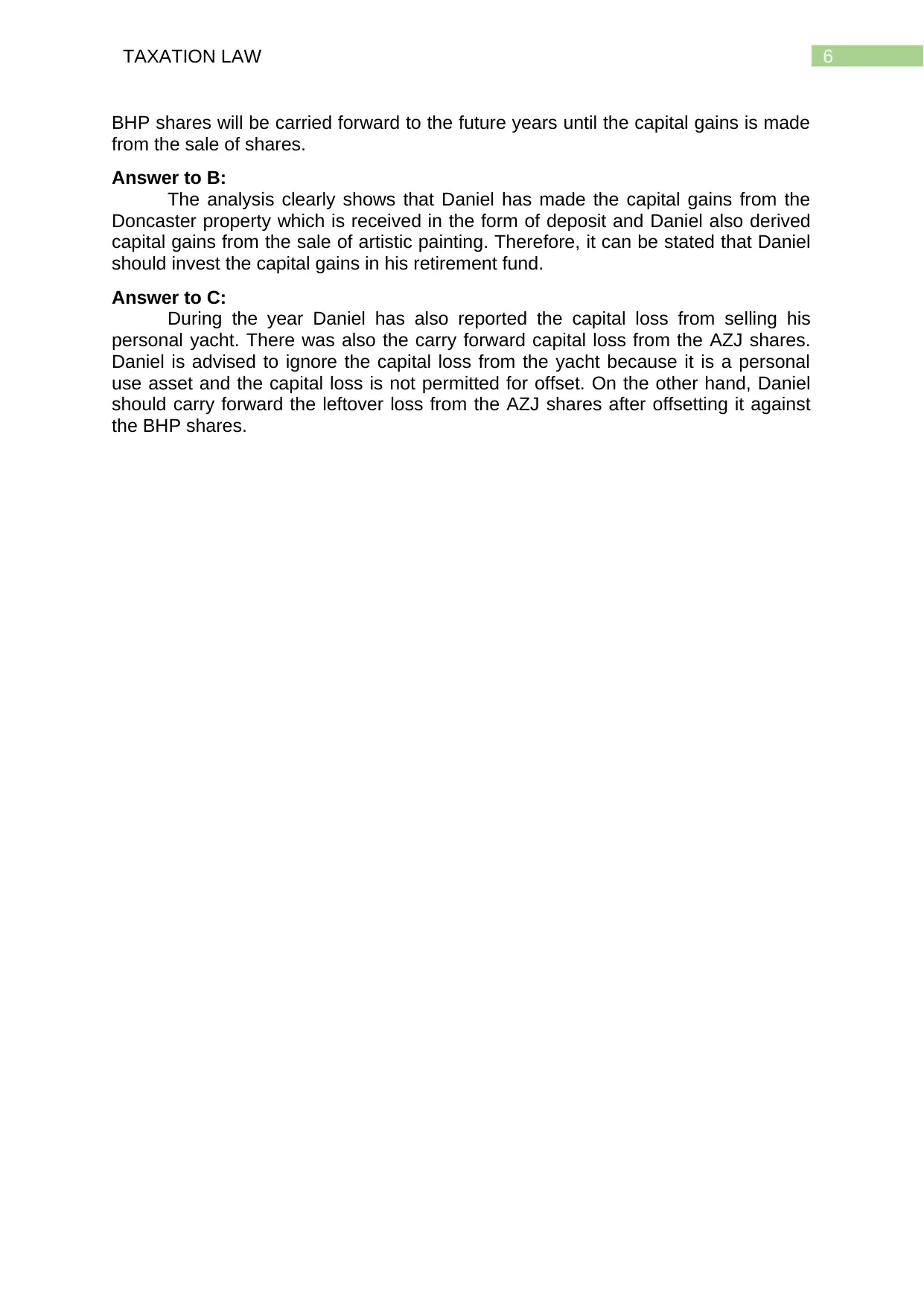
6TAXATION LAW
BHP shares will be carried forward to the future years until the capital gains is made
from the sale of shares.
Answer to B:
The analysis clearly shows that Daniel has made the capital gains from the
Doncaster property which is received in the form of deposit and Daniel also derived
capital gains from the sale of artistic painting. Therefore, it can be stated that Daniel
should invest the capital gains in his retirement fund.
Answer to C:
During the year Daniel has also reported the capital loss from selling his
personal yacht. There was also the carry forward capital loss from the AZJ shares.
Daniel is advised to ignore the capital loss from the yacht because it is a personal
use asset and the capital loss is not permitted for offset. On the other hand, Daniel
should carry forward the leftover loss from the AZJ shares after offsetting it against
the BHP shares.
BHP shares will be carried forward to the future years until the capital gains is made
from the sale of shares.
Answer to B:
The analysis clearly shows that Daniel has made the capital gains from the
Doncaster property which is received in the form of deposit and Daniel also derived
capital gains from the sale of artistic painting. Therefore, it can be stated that Daniel
should invest the capital gains in his retirement fund.
Answer to C:
During the year Daniel has also reported the capital loss from selling his
personal yacht. There was also the carry forward capital loss from the AZJ shares.
Daniel is advised to ignore the capital loss from the yacht because it is a personal
use asset and the capital loss is not permitted for offset. On the other hand, Daniel
should carry forward the leftover loss from the AZJ shares after offsetting it against
the BHP shares.
Paraphrase This Document
Need a fresh take? Get an instant paraphrase of this document with our AI Paraphraser
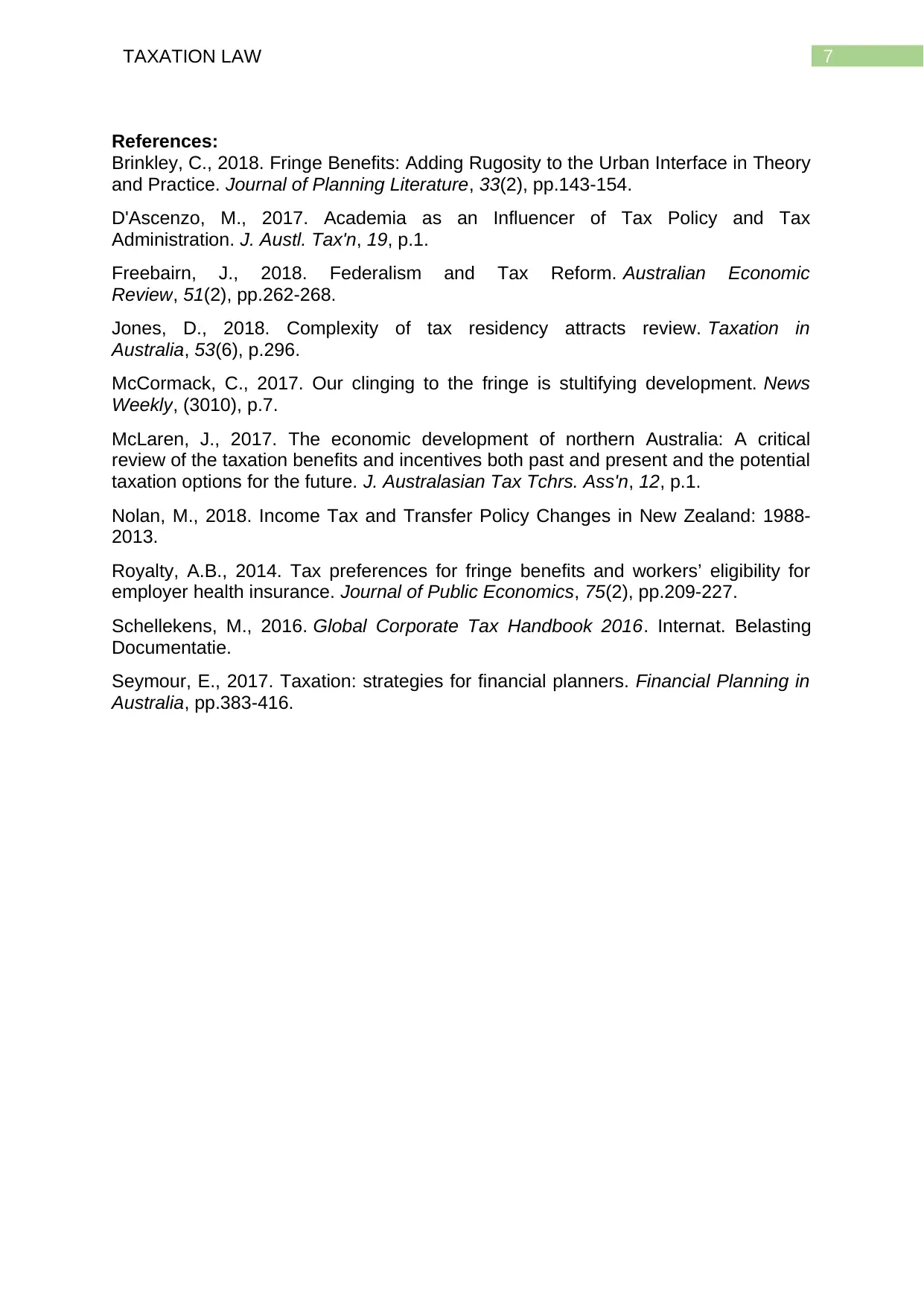
7TAXATION LAW
References:
Brinkley, C., 2018. Fringe Benefits: Adding Rugosity to the Urban Interface in Theory
and Practice. Journal of Planning Literature, 33(2), pp.143-154.
D'Ascenzo, M., 2017. Academia as an Influencer of Tax Policy and Tax
Administration. J. Austl. Tax'n, 19, p.1.
Freebairn, J., 2018. Federalism and Tax Reform. Australian Economic
Review, 51(2), pp.262-268.
Jones, D., 2018. Complexity of tax residency attracts review. Taxation in
Australia, 53(6), p.296.
McCormack, C., 2017. Our clinging to the fringe is stultifying development. News
Weekly, (3010), p.7.
McLaren, J., 2017. The economic development of northern Australia: A critical
review of the taxation benefits and incentives both past and present and the potential
taxation options for the future. J. Australasian Tax Tchrs. Ass'n, 12, p.1.
Nolan, M., 2018. Income Tax and Transfer Policy Changes in New Zealand: 1988-
2013.
Royalty, A.B., 2014. Tax preferences for fringe benefits and workers’ eligibility for
employer health insurance. Journal of Public Economics, 75(2), pp.209-227.
Schellekens, M., 2016. Global Corporate Tax Handbook 2016. Internat. Belasting
Documentatie.
Seymour, E., 2017. Taxation: strategies for financial planners. Financial Planning in
Australia, pp.383-416.
References:
Brinkley, C., 2018. Fringe Benefits: Adding Rugosity to the Urban Interface in Theory
and Practice. Journal of Planning Literature, 33(2), pp.143-154.
D'Ascenzo, M., 2017. Academia as an Influencer of Tax Policy and Tax
Administration. J. Austl. Tax'n, 19, p.1.
Freebairn, J., 2018. Federalism and Tax Reform. Australian Economic
Review, 51(2), pp.262-268.
Jones, D., 2018. Complexity of tax residency attracts review. Taxation in
Australia, 53(6), p.296.
McCormack, C., 2017. Our clinging to the fringe is stultifying development. News
Weekly, (3010), p.7.
McLaren, J., 2017. The economic development of northern Australia: A critical
review of the taxation benefits and incentives both past and present and the potential
taxation options for the future. J. Australasian Tax Tchrs. Ass'n, 12, p.1.
Nolan, M., 2018. Income Tax and Transfer Policy Changes in New Zealand: 1988-
2013.
Royalty, A.B., 2014. Tax preferences for fringe benefits and workers’ eligibility for
employer health insurance. Journal of Public Economics, 75(2), pp.209-227.
Schellekens, M., 2016. Global Corporate Tax Handbook 2016. Internat. Belasting
Documentatie.
Seymour, E., 2017. Taxation: strategies for financial planners. Financial Planning in
Australia, pp.383-416.
1 out of 8
Related Documents
Your All-in-One AI-Powered Toolkit for Academic Success.
+13062052269
info@desklib.com
Available 24*7 on WhatsApp / Email
![[object Object]](/_next/static/media/star-bottom.7253800d.svg)
Unlock your academic potential
Copyright © 2020–2025 A2Z Services. All Rights Reserved. Developed and managed by ZUCOL.





